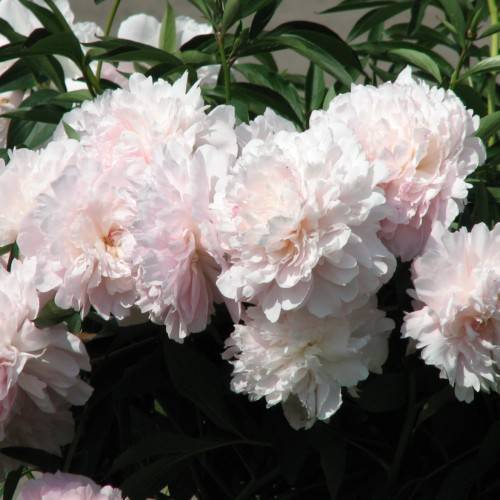
peony
Paeonia lactiflora 'Madame Calot'
Cycle:
Herbaceous Perennial
Watering:
Average
Hardiness Zone:
3 - 8
Flowers:
Flowers
Sun:
Full sun,part shade
Leaf:
Yes
Growth Rate:
Low
Maintenance:
Moderate
watering
Peony (Paeonia lactiflora 'Madame Calot') prefers moist soil, but should not be over-watered or allowed to sit in overly wet soil. Water your peony deeply once a week, or more frequently on very hot days. For newly planted peonies, water about 1 inch of water every week. Allow the soil to become slightly dry between waterings to encourage strong root growth. Increase watering in late summer/fall to promote better root growth.
sunlight
Peony (Paeonia lactiflora 'Madame Calot') requires 6-8 hours of direct sunlight each day for optimum flowering. Direct sunlight in the morning is especially beneficial as the blossom buds tend to become heat-stressed when exposed to the strong afternoon sun. The plant should be planted in a location that does not get too much shade, but at the same time is protected from extreme afternoon sunlight. Peony plants also prefer slightly acidic soil and good drainage, providing plenty of organic matter to aid root growth. Water the plant once a week, but avoid watering the foliage to prevent disease and reduced plant health.
pruning
Pruning peonies (Paeonia lactiflora 'Madame Calot') should be done in late fall, after the first hard frost. While pruning is not strictly necessary, it can help keep the plant healthy by removing any dead, diseased, or damaged stems. Use sharp pruners to remove branches in a downward angle, at a 45-degree angle from the branches. Avoid removing more than 1-third of the entire stems of the plant. To encourage new growth, lightly prune back each stem to about 1-third of the stem. If the branches are crowded, a more aggressive pruning is necessary. Remove only 1-third of the stems, leaving at least 2-thirds for new growth.
Propagation
Season
Hardiness Map
FAQ
Is the Peony popular flower in Canada?
Yes, the peony is a popular flower in Canada. It is highly prized for its showy blooms and long-lasting beauty. Peonies have been cultivated in Canada for centuries, and their popularity is due in part to their long-lasting blooms and hardiness in colder temperatures. Peonies are a popular choice in Canadian gardens, and flower arrangements. They are also used in bouquets and centerpieces, where their stunning colors really shine.
Are Peonies fragrant?
Yes, peonies are quite fragrant. Depending on the variety of peony, the scent can be described as sweet, floral, and citrusy. Some of the most popular and aromatic varieties of peony include 'Pillow Talk', 'Fairy Tale', and the 'Duchess De Nemours'. Peonies are often used in floral arrangements and can even be grown in your garden for a fresh, summery scent.
Can Peonies be grown in partial shade?
Yes, peonies can be grown in partial shade. While they require at least 6 hours of sunlight per day during the first half of the growing season, the second half is best if the plants can receive a few hours of shade. As long as the area is not completely shaded, the peonies should do well. These plants are also hardy, so they can generally thrive in a variety of locations.
Do Peonies require well-drained soil?
Yes, peonies do require well-drained soil in order to grow and flourish. Planting them in heavy clay soil can cause the roots to rot, as the soil will stay wet for too long. To ensure good drainage and aeration, it is recommended that the soil is amended with organic matter like compost or peat moss. The soil should also be slightly acidic, with a pH of 6.0-7.0. Additionally, peonies may need to be watered more often during the summer, as they are prone to wilt in hot temperatures.
Should Peonies be staked to prevent damage?
Yes, it is a good idea to stake peonies to prevent damages. Peonies are naturally tall and floppy flowers and as such, can easily be damaged by strong winds and heavy rain. Staking is a great way to keep tall peonies from sprawling or falling over which could damage the stems or flowers. When staking your peony, use tall, sturdy stakes that support the main stem of the plant. You can use metal or bamboo stakes, but be sure to avoid stakes with sharp edges or points as those could damage the plant or injure those tending the garden. Utilizing a supporting structure for your peony will help it to look its best.
Is the Peony a long-lived perennial plant?
Yes, the Peony is a long-lived perennial plant. It can live for more than 20 years in the proper conditions, and can even last for generations with proper care and maintenance. Peonies prefer cooler climates, and well-drained soil with a relatively high pH level. They will grow to approximately 2 -3 feet in height, with heart-shaped foliage and blooms in shades of white, pink, and red. Peonies typically bloom in late spring or early summer months and make an excellent addition to any garden.
